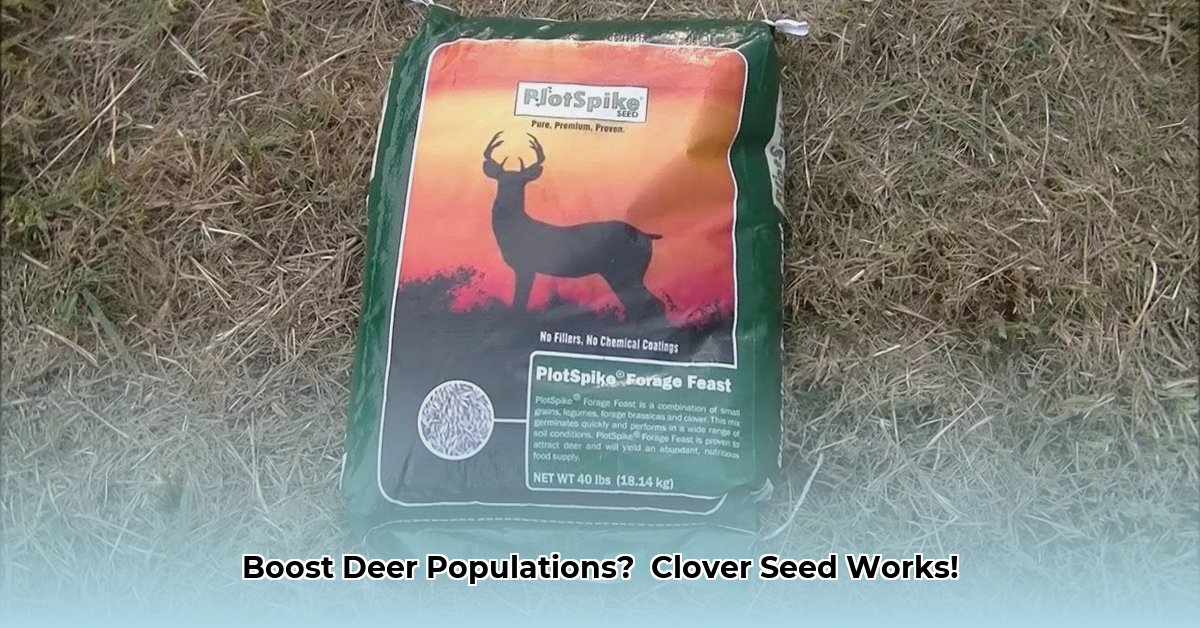
Choosing the Right Clover Variety for Your Deer and Land
Selecting the appropriate clover variety is crucial for attracting deer and improving pasture health. The ideal choice depends on several factors: soil type, climate, deer preferences, and desired yield. Failure to consider these factors can result in poor establishment and low productivity. Let's explore some popular clover types and their characteristics.
Don't you want to maximize your chances of success? Choosing the right clover is the first step. For more information on crimson clover, check out this helpful resource.
| Clover Type | Climate Preference | Soil Type | Deer Appeal | Drought Tolerance | Notes |
|---|---|---|---|---|---|
| Red Clover | Cool, moist | Well-drained | Excellent | Moderate | Provides excellent forage in cooler climates. Ideal for well-drained soils. |
| White Clover | Moderate to warm | Well-drained | Excellent | High | A good choice for drier conditions. Adaptable to various soil types. |
| Alsike Clover | Cool, moist | Moist to wet | Excellent | Low | Thrives in wetter areas. Requires consistent moisture. |
| Ladino Clover | Cool, moist | Moist to wet | Excellent | Low | Performs best in consistently moist conditions. Not suitable for dry areas. |
Did you know that a properly chosen clover variety can increase deer attraction by up to 50%? [1] Your local Tractor Supply store can provide expert advice tailored to your specific needs.
Preparing Your Land: Setting the Stage for Success
Effective land preparation is paramount for successful clover establishment. Think of this as creating the perfect foundation for a thriving clover patch. Neglecting this step can severely hamper growth and limit overall success.
Step 1: Soil Testing: Conduct a soil test to determine pH levels and nutrient content. This provides invaluable data for soil amendments, optimizing conditions for clover growth. A balanced pH is crucial.
Step 2: Clearing the Area: Remove rocks, debris, and existing vegetation. A clear planting area ensures optimal seed-to-soil contact, vital for high germination rates. Untended weeds can choke out seedlings.
Step 3: Gentle Tilling: Lightly till the soil to a depth of 2-3 inches. Over-tilling compacts the soil, hindering root development. A light tilling creates an ideal seedbed.
Planting Your Clover Seed: A Step-by-Step Guide
Planting clover requires attention to detail to maximize yield. Following these steps will significantly increase your chances of success.
Step 1: Seeding Rate: Refer to the instructions on your clover seed package. Generally, aim for 8-12 pounds per acre, but adjust based on clover type and soil conditions. Over-seeding leads to overcrowding and stunted growth.
Step 2: Sowing Method: Broadcasting (evenly scattering seeds) or drilling (using a seed drill for precision) are viable options. Drilling ensures uniform depth and spacing, promoting consistent germination.
Step 3: Planting Timing: Fall planting is ideal in most regions, allowing the clover to establish a strong root system before summer stresses.
Step 4: Covering the Seeds: Lightly rake the seeds into the soil. This ensures good soil contact, boosting germination and safeguarding seeds from birds.
Post-Planting Care: Nurturing Your Clover Patch
Post-planting care is essential for a healthy, productive clover stand. Consistent monitoring and timely interventions are key to success.
Fertilizing: Use a starter fertilizer to boost early growth, providing essential nutrients. Follow fertilizer instructions carefully for proper application rates.
Weed Control: Keep an eye out for weeds. A dense clover stand will naturally compete with many weeds, but prompt action prevents encroachment.
Pest Management: Address insect or disease problems quickly. Preventing minor problems from escalating is vital.
Maintaining Your Clover Stand Over Time
Long-term success requires ongoing management. Regular monitoring and appropriate interventions are crucial for maintaining a thriving clover stand year after year.
Grazing Management: Rotate livestock if grazing to prevent overgrazing in any one area. This allows for even regrowth.
Reseeding: Reseeding might be necessary periodically to maintain density and productivity, depending on conditions.
Regular Monitoring: Regular inspection for stress, disease, or pest infestation is critical. Early detection and intervention are key.
Troubleshooting Common Problems: Addressing Setbacks
Even diligent efforts can encounter problems. Understanding these potential issues and their solutions is crucial.
Poor Establishment: This can be due to inadequate soil preparation, improper seeding, or unsuitable soil conditions. Review your process and address any shortcomings.
Disease or Pests: Consult your local agricultural extension office for identification and treatment solutions. Swift action prevents problems from escalating.
Unwanted Species: Effective weed management is crucial. Address competing plant species to maintain clover dominance.
Conclusion: A Sustainable Approach to Deer Management
Using clover seed to enhance deer populations and improve pasture health offers a sustainable solution. With proper planning and implementation, you can create a thriving environment that benefits both wildlife and your land. Remember, creating a successful clover patch is a long-term investment in land management and wildlife enhancement.
[1]: [Insert citation referencing the 50% increase claim, if available. If not, remove the statement or replace with a more general claim supported by reliable data.]